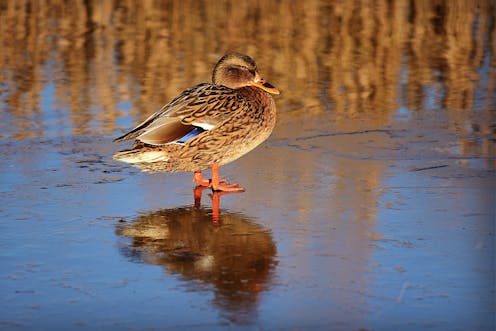
When filled with ice-skaters or a clumsy Bambi on a Christmas card, a frozen pond is a merry sight. But spare a thought for the living things trapped below. The aerial wizardry of dragonflies and summer sculling of pond skaters are long gone. As the cold grips and shadows lengthen over the pond, its inhabitants face a terrible enemy: ice.
But while the cold of winter is a threat to most wildlife, it can be endured. Many land-based creatures – particularly amphibians such as toads and newts, and other animals without spines known as invertebrates – have evolved the ability to cool their bodily fluids down to below zero. This allows them to sit out the lean months of winter without freezing.
For example, the wood frog can cope with up to 70% of the water inside its body turning to ice. These frogs don’t lurk, iced up, in ponds, however – they nestle in the dry leaf litter of the woodland floor. They only head to ponds once they have thawed out in springtime, warmed up and ready for some frenzied reproduction.
During winter, the biggest danger for the pond life that becomes trapped in ice is internal freezing, as expanding ice wreaks havoc on cells and tissues.
Winterkill is coming
Hibernating pond invertebrates such as beetles, dragonfly larvae and waterboatmen (a type of aquatic bug) get around this problem by allowing internal fluids to freeze. Proteins in their blood encourage the formation of ice crystals which draw water out of vulnerable tissue. These little creatures are not only frozen but dried out – and all the safer for it.
Other bugs rely on natural antifreeze chemicals in their fluids to resist freezing at temperatures well below 0°C. Researchers tested several species of pond and stream beetle, mayfly and mollusc and found all of them could cool their internal temperature in water to between -3 and -7°C. However, if the ice ensnared them, even at higher temperatures, they were doomed.

Some pond invertebrates prepare for winter by secreting insulating cocoons. The majority try to find refuge in deeper water or another pond, although some Prairie Pothole water boatmen huddle together in icebound clusters. This mass of dark little bodies may thaw out faster in the springtime sunshine, but not all will make it through alive.
Many species succumb, and scientists call these mass deaths in iced-over ponds “winterkill”. At least one study has showed that numbers of invertebrates, tadpoles and fish can take years to recover from such a freeze. However, winterkill may also bring smaller inhabitants of ponds some longer-term benefits.
The word “winterkill” comes from fisheries, where the effect of prolonged ice cover and reduced oxygen – as gases dissolve less effectively and oxygen from plants is limited as they too die back – has long been known to kill lots of fish.
A fortuitous experiment on four frozen Albertan lakes, which were monitored for five years, showed the ecological consequences of winterkill clearly.
In two of the lakes, it did away with most of the fish – yet the other two, which were comparable in other ways, were unaffected. Invertebrate numbers shot up in the lakes where the fish died, with freshwater shrimps, caddisflies and midges particularly benefiting, but not in the other two.
Winterkill is a great example of how disturbances reset the ecological stage with a new cast of characters, creating richness and variety across the landscape.
What to do if you have a pond
What should you do if you have a pond (or more than one – a cluster is usually best for maximising the diversity of invertebrates and plants) that freezes? Reams of blogs and leaflets offer advice on this topic.

Sweeping the snow off a pond and keeping some of its surface ice-free may well help aquatic life by letting in sunlight. But never smash a hole in the ice, since it might shock the fish to death. Indeed, when I last saw this attempted, the friend doing the smashing slipped over and landed in a sodden heap, so he was quite shocked too. Icy ponds are dangerous places so doing anything that risks you falling in is definitely best avoided.
Of course, our wildlife has been living with winterkills for thousands of years. Much better to make sure the whole landscape is rich in all sorts of ponds – shallow, deep, large, small, temporary or freezing – and then the frogs and bugs will do just fine on their own.
Mike Jeffries does not work for, consult, own shares in or receive funding from any company or organisation that would benefit from this article, and has disclosed no relevant affiliations beyond their academic appointment.
